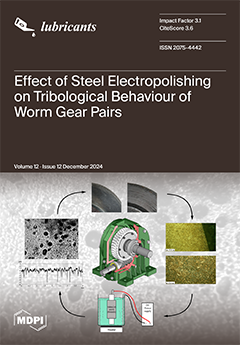Titanium possesses many useful properties and is a technologically important material in engineering. However, lubrication of titanium has long been a problem that has prevented titanium from being more widely used. This is due to its poor tribological properties, deriving from its high
[...] Read more.
Titanium possesses many useful properties and is a technologically important material in engineering. However, lubrication of titanium has long been a problem that has prevented titanium from being more widely used. This is due to its poor tribological properties, deriving from its high tendency towards adhesive wear, material transfer, and abrasive wear. Lubrication is a system engineering which involves material combinations, material surfaces, lubricants, and operating conditions as a system. In this work, the boundary lubrication behavior of commercially pure titanium (CP-Ti) sliding against various counterbody materials in a motor oil (0W-30) was investigated under ball-on-plate reciprocating sliding conditions. The counterbody materials (balls) include CP-Ti, ceramic (Al
2O
3), steel (AISI 52100), and polymer (nylon). The results show that depending on material combination, the lubricating behavior can be divided into three categories, i.e., (1) lubrication failure (Ti-Ti), (2) improved lubrication but with friction instability (Ti-Al
2O
3), and (3) effective lubrication (Ti–steel and Ti–nylon). Lubrication failure of the Ti-Ti pair leads to high and unstable friction and severe wear from both the plate and ball, while friction instability of the Ti-Al
2O
3 pair leads to friction spikes and high wear rates. Effective lubrication of the Ti–steel pair results in low and smooth friction and much-reduced wear rates of the Ti plate by nearly 10,000 times. However, there is a load-dependence of the lubrication effectiveness of the Ti–steel pair. Although the Ti–nylon pair is effectively lubricated in terms of much-reduced friction, the nylon ball suffers from severe wear. The friction and wear mechanisms of the various sliding pairs are discussed in this paper.
Full article





